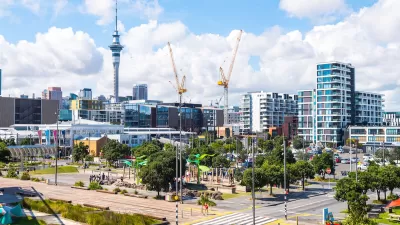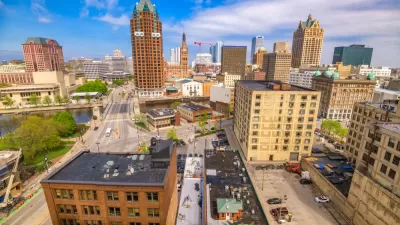As the housing market collapsed and gasoline prices spiked in 2007, many planners may have read Cornell University law professor Eduardo Penalver’s essay in the Washington Post with more than a little satisfaction.
As the housing market collapsed and gasoline prices spiked in 2007, many planners may have read Cornell University law professor Eduardo Penalver's essay in the Washington Post with more than a little satisfaction. "But if there is consolation to be found amid the rubble [of the housing crisis]," professor Penalver wrote, "it may be that the inexorable spreading out that has characterized American life since World War II might finally be coming to an end."
This wish, however, is based on two highly suspect premises: The quest for larger homes and more land is based on transient and opportunistic desires, and long-run housing choices are constrained by current transportation technologies. Both premises are false, and ignoring them will fundamentally compromise attempts to: 1) build new cities, and 2) revitalize our existing ones. Do to length constraints, however, I'm going to focus on the first problem in this blog post.
Despite conventional wisdom, decentralization and suburbanization are not unique to the United States or, for that matter, the post-World War II period. These trends are well established in the urban (if not planning) literature, and useful historical summaries can be found in architectural historian Robert Bruegmann's Sprawl: A Compact History, urban analyst Joel Kotkin's City: A Global History (Modern Library, 2005), and economist William T. Bogart's Don't Call It Sprawl: Metropolitan Structure in the Twenty-First Century. They are part of the long wave of urban development as higher incomes allow families to buy and move into homes that had more rooms, more bedrooms, more bathrooms, open floor plans, garages and private yards. Older cities, often built on a supply of tenement housing to feed rapid population and employment growth, simply didn't have large supplies of new housing. The five and seven floor "walk ups" often housed four or more families per floor, had poor ventilation, few windows, and little access to open space. Newly developed suburban tract housing provided a meaningful alternative. More importantly, these housing characteristics that make suburbs attractive are still valued in the marketplace.
Economists use "hedonic" pricing models to tease out the features of a home that are more (or less) valued by consumers. The idea is to break down the components of a home's value by its specific characteristics, including square footage, lot size, number of bedrooms, bathrooms, and other amenities (e.g., swimming pools, garages, etc.). While not without criticism, these methods provide a reliable quantitative approach to figuring out what the average or "typical" housing consumer values if results are consistent across different cases and studies.
A review of dozens of econometric hedonic studies over the past decade by Florida State University economists G. Stacy Sirmans and David Macpherson found that the lot size, number of bathrooms, home square footage, and even the presence of a swimming pool significantly increased home value. More strikingly, of the 64 studies that have examined the influence lot size has on home value, 54 found a positive relationship: as lot size increased, home value increased. Ten studies found no statistically significant impact. None of the studies found a negative relationship. In other words, the housing consumers consistently and persistently valued larger lots in their choice over new home purchases.
Meanwhile, of the 78 studies that included the age of a home, the effect was negative in 63 cases, positive in seven, and had no effect in eight studies. Since older cities tend to have older homes with fewer of the characteristics contemporary buyers want-more bedrooms, bathrooms, etc.-traditional cities have trouble competing in the housing market.
The takeaway for planners and planning is that attracting households to older cities is an uphill battle. Rejuvenating existing and older neighborhoods requires allowing the real-estate market to adjust to fit the styles and preferences of contemporary families. In the words of current president of the Congress for the New Urbanism and former Milwaukee Mayor John Norquist in his insightful and readable book The Wealth of Cities: Revitalizing the Centers of American Life (p. 196). Developers and builders in older cities "can't take the attitude that people should live in the city because it's the right thing to do, nor can they pin their hopes strictly on historical appeal. City homes need the amenities people want."
This doesn't mean older cities must try to replicate suburban (or ex-urban) housing. On the contrary, most older neighborhoods and cities can't (and shouldn't). Rather, the research implies that cities must focus on offsetting the negative effects of smaller yards and more dense living with high-value urban amenities that compensate for the features consumers want but can't get in these environments.
Of course, this is easier said than done. Urban neighborhoods are inherently more complex because they must juggle mixed uses, multiple transportation modes and higher densities, attempting to find a combination that will satisfy fickle consumer demand. The complexity of urban redevelopment projects and infill-development in already built-up cities-demands a nimble, flexible and expeditious regulatory process to minimize development costs and allow the market to adapt quickly to more finely grained tastes for housing. One of the chief tasks facing planners is developing and applying streamlined zoning and development controls that accommodate this kind of development to replace the cookie-cutter planning and zoning procedures that more typically impose a cumbersome, uncertain and inefficient approval process on land use and redevelopment decisions.

Trump Administration Could Effectively End Housing Voucher Program
Federal officials are eyeing major cuts to the Section 8 program that helps millions of low-income households pay rent.

Planetizen Federal Action Tracker
A weekly monitor of how Trump’s orders and actions are impacting planners and planning in America.

Ken Jennings Launches Transit Web Series
The Jeopardy champ wants you to ride public transit.

California Invests Additional $5M in Electric School Buses
The state wants to electrify all of its school bus fleets by 2035.

Austin Launches $2M Homelessness Prevention Fund
A new grant program from the city’s Homeless Strategy Office will fund rental assistance and supportive services.

Alabama School Forestry Initiative Brings Trees to Schoolyards
Trees can improve physical and mental health for students and commnity members.
Urban Design for Planners 1: Software Tools
This six-course series explores essential urban design concepts using open source software and equips planners with the tools they need to participate fully in the urban design process.
Planning for Universal Design
Learn the tools for implementing Universal Design in planning regulations.
Ada County Highway District
Clanton & Associates, Inc.
Jessamine County Fiscal Court
Institute for Housing and Urban Development Studies (IHS)
City of Grandview
Harvard GSD Executive Education
Toledo-Lucas County Plan Commissions
Salt Lake City
NYU Wagner Graduate School of Public Service






























